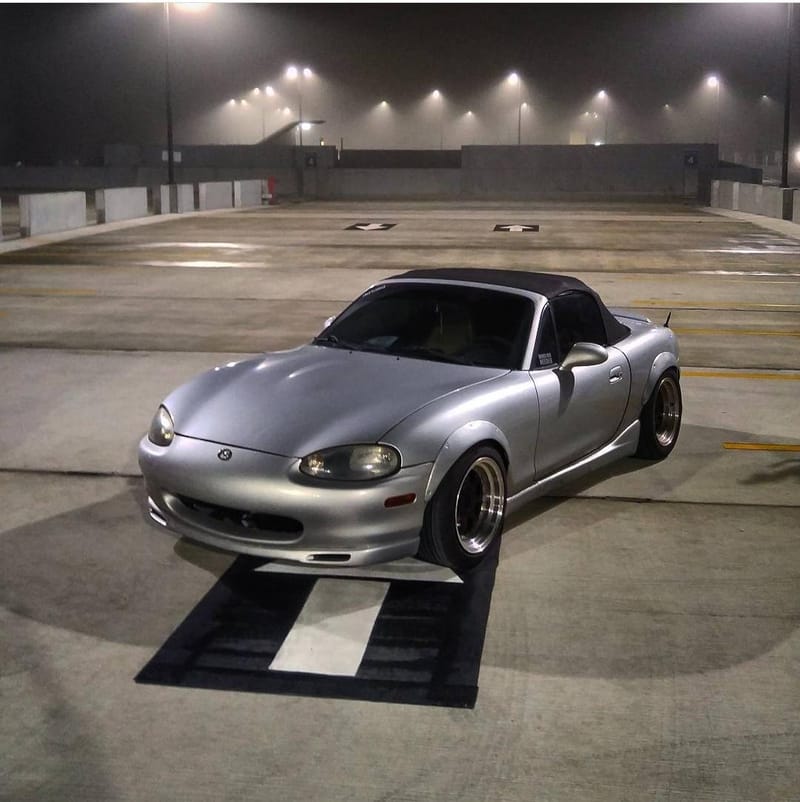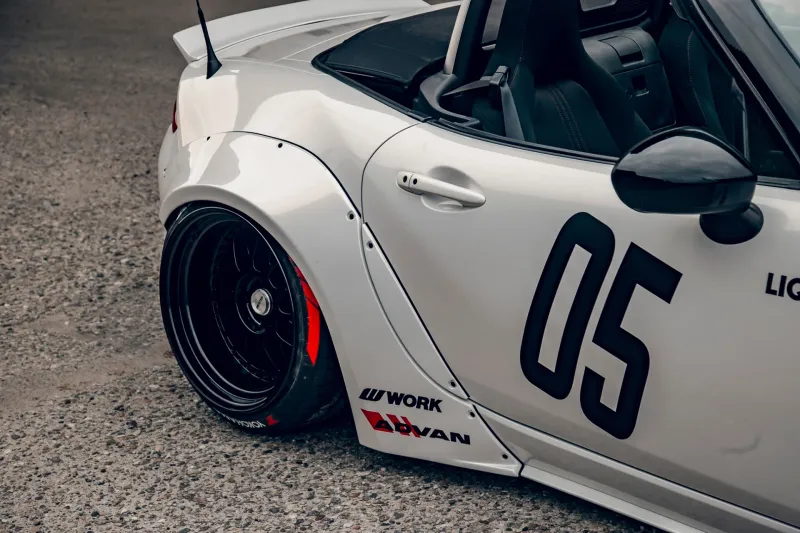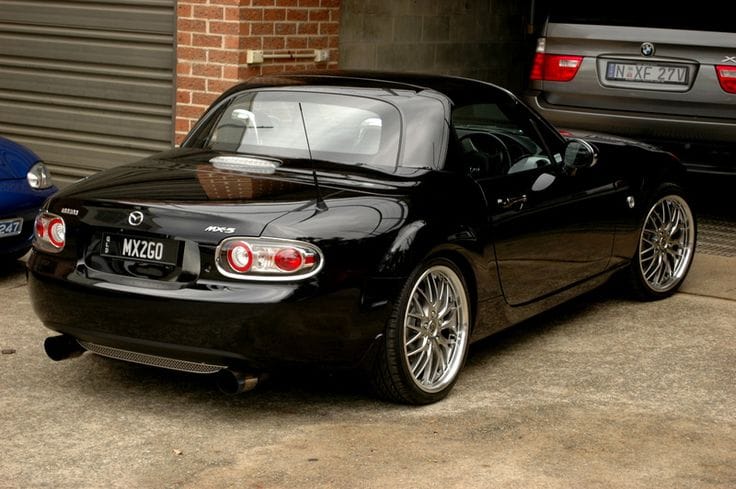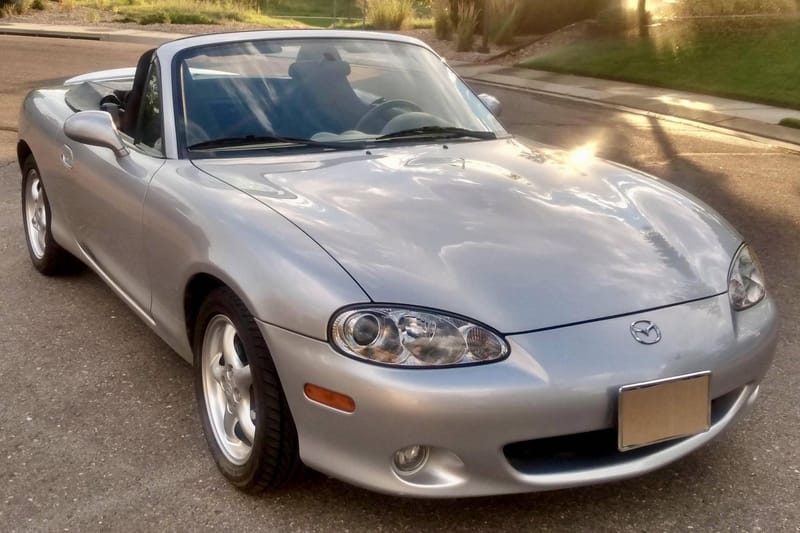Race/Autocross Aerodynamics Guide for your MX-5
NA and NB Miatas generate lift at high speeds, making the rear feel unstable. A spoiler or wing reduces lift, improving grip. Consider alignment, suspension, and driving speed before upgrading. Spoilers, wings, and ducktails all offer stability gains.
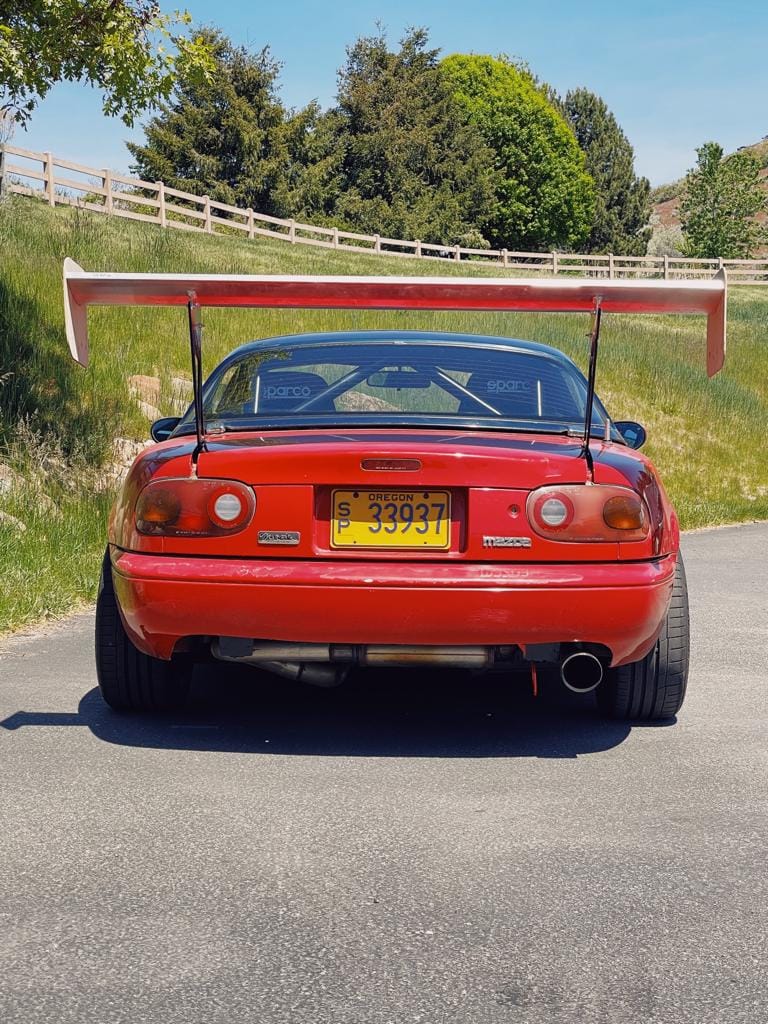
The Miata’s charm lies in its light and agile nature, but once you start adding power, especially in the case of a turbocharged setup, you’ll find yourself pushing speeds well beyond 110–120 mph at track days or on long straights. At those higher velocities, the NA and NB generations of the MX-5 can feel noticeably unstable in the rear, primarily because of the car’s design and aerodynamic profile. Compounding this, if you’re running with the top down, the turbulence rolling over the windshield and into the cabin disrupts the airflow around the trunk, further increasing rear-end lift.
When you notice that floaty feeling or twitchiness at the rear, adding some form of rear aero (a wing or a spoiler) can help. By reducing the amount of lift generated, you keep more weight on the rear tires, promoting stability and confidence. However, you need to stay aware that more rear grip at higher speeds can shift your car’s handling balance toward understeer. That’s not necessarily a bad thing if your Miata’s rear end is already prone to stepping out, but it does mean you may want to consider some matching front aero later on.
Aerodynamics 101 for Miatas
At higher speeds, the NB Miata in particular produces a fair amount of rear lift, causing the car to feel light or unsettled in fast corners or long straights. A spoiler, typically mounted directly on the trunk lip, modifies airflow just enough to reduce that lift, effectively stabilizing the rear. On the other hand, a wing, often mounted above the trunk line, can generate actual downforce when set at the right angle of attack, offering a more substantial improvement in grip.
Another factor is whether you drive with the convertible top up or down. With the top up, air flows more smoothly from the windshield over the roof, then over the trunk. When you drop the top, air spills into the cabin, creating additional drag and sometimes more turbulent flow around the trunk. This can make a Miata more unstable at speed. If you’re chasing every last bit of stability, just putting the top up can be an easy improvement.

When adding rear aero, always remember it can shift your car’s aerodynamic center of pressure backward. That might translate into understeer if you do nothing about the front. That’s why a small front splitter, lip, or air dam is often added to help keep the front tires pressed to the track as well.
Key Pre-Aero Considerations
Before drilling holes for a spoiler or ordering that massive GT wing, take a moment to ensure your mechanical setup is solid. The Miata’s alignment settings, toe, camber, caster, plus a proper rake (slightly lower front than rear) can cure some of the instability you feel at speed. Suspension components like sway bars and dampers should also be set up to give you a balanced car. If the rear sway bar is too stiff, you may be dealing with oversteer in lower-speed corners that no amount of aero will fix at higher speeds.
It’s also important to consider how fast you typically drive. If you do mostly autocross, you’re unlikely to exceed 80 mph, so a giant race wing may not be the best investment unless you’re in a class that allows and benefits from extreme aero. If you attend track days where you regularly reach 100 mph or more, then even a simple trunk lip spoiler can make a noticeable difference. For seriously boosted Miatas that see 120 mph or more, a larger wing or well-designed spoiler can be transformative.

Finally, think about how much power you have. A turbo Miata can push through the extra drag created by a larger wing more easily than a stock NA or lightly modified NB. If you’re still on relatively low horsepower, you may be happier with a more efficient spoiler or a smaller wing that won’t eat into your top speed as much.
Options for Rear Aero
Miata owners have several popular methods for reducing rear lift and improving stability, each with different levels of cost, installation complexity, and performance potential.
A small trunk-lip spoiler, like a Mazdaspeed (MSM) piece or a ducktail, gives a moderate improvement by “tripping” the airflow off the trunk. These are easy to install, often require minimal hardware, and don’t drastically alter the car’s look or create too much drag. They won’t make a huge difference at the extremes, but they can be just what you need for moderate track speeds.
Stepping up in size, you can find “street” or “mild track” wings that are a bit taller than a simple spoiler but still below roof height. These produce more downforce (or at least reduce lift more significantly), giving you a more planted feel in faster corners. They create more drag, though, and the mounting process typically involves drilling and careful measuring.

At the high end are large, tall “race” wings that extend to or above the Miata’s roofline. These can generate hundreds of pounds of downforce if properly designed and adjusted, which is fantastic for cornering grip at speed. The trade-off is an obvious one: more drag, a much bolder look, and a heftier price tag. Mounting them can also be a bigger job, sometimes requiring chassis mounting for stability and strength.

Another avenue is a “ducktail” or “longtail” style spoiler that extends the trunk’s shape rearward and upward. These can clean up airflow in a way that sometimes reduces both drag and lift. While not as outright powerful as a tall wing, they can offer a nice balance of looks, mild downforce, and improved stability.

The Importance of Front Aero Balance
Once you’ve added rear aero, consider the potential shift in handling balance. If you feel the front end becoming vague or pushing (understeer) at higher speeds, it might be time for a small front lip, a splitter, or an air dam. Many NB Miatas came with or can be fitted with a subtle factory lip, and even that small piece can help direct airflow around rather than underneath the nose.
More serious track cars will often run a noticeable front splitter that juts out a few inches from the bumper. This creates a high-pressure zone on top of the splitter and low pressure underneath, generating meaningful front-end downforce. Some drivers also install canards, small dive plates on the bumper, to fine-tune airflow around the corners of the car. And if you want to get really detailed, a flat undertray or floor and a rear diffuser can further reduce drag and help keep the car stable.
Real-World Suggestions from Track Enthusiasts
Enthusiasts often say that simply running the Miata with the soft top or a hardtop in place can noticeably reduce the feeling of rear lift. Before you spend money on new aero parts, try a few fast laps with the top up and see if it makes enough of a difference.
Those who install a basic lip spoiler generally report that their Miata becomes less jittery when crossing the 100–130 mph range. Others prefer a moderate “street” wing for an even firmer planted feel, but without drawing too much attention on the road. If you’re aiming for maximum downforce, especially if you have a big turbo setup, a tall wing paired with a front splitter is typically the go-to for track performance.
However, many track junkies emphasize that no matter what wing or spoiler you buy, you have to dial in your mechanical grip first. An oversteering car at 40 mph might still have messy rear dynamics at 120 mph if the fundamental suspension settings are off. Some owners even keep a spare trunk lid so they can swap in a winged version on track weekends and return to a cleaner look on the street.
Practical Installation Tips
If you do decide on a spoiler or wing, expect to drill holes in your trunk lid. With lip spoilers, it’s usually just a few holes. For bigger wings, you might need to reinforce certain areas or mount at the trunk edges, or even attach the brackets to the frame rails for maximum rigidity. It’s wise to follow the manufacturer’s guidelines carefully to avoid leaks or misaligned parts.
If your wing is adjustable, start with a low angle of attack. As you get seat time, gradually increase it and see how it affects both corner speed and straight-line drag. Keep an eye on data, if you have a lap timer or logger, look at mid-corner speeds and terminal velocity on the straights. This objective data can confirm whether you’re gaining cornering grip without slowing down too much on the fastest sections.
Finally, remember that even a mild rear spoiler can alter balance. If you start to notice more understeer at higher speeds, look into a small front lip, adjusting your shock settings, or lowering front tire pressure slightly. Sometimes a tiny tweak up front can bring the balance right back.
For casual track enthusiasts, a small trunk spoiler or a mild street wing can provide enough high-speed stability to feel more confident without transforming your Miata into something unrecognizable. If you’re chasing lap records, a full-blown high-mount wing plus a front splitter is the best way to achieve serious levels of cornering grip, but you’ll need to accept higher drag and a more extreme look.
No matter what, always keep your front and rear aero in harmony. The Miata’s lightweight design means that any imbalance can become apparent very quickly once you pass the century mark on the speedometer. Also, remember that simply putting the top up might be enough of an improvement if you’re on a tight budget. And, of course, never neglect the basics: alignment, suspension, tires, and brake setup should all be solid before you start adding wings and splitters.
For those who want flexibility, a spare trunk lid is a great solution to make your aero more of a temporary, track-focused addition. That way, you can maintain the classic Miata look during the week and roll into the weekend with a spoiler or wing that keeps you glued to the track.
Additional Resources
Should you be ready to shop, companies like Nine Lives Racing offer various Miata-specific wings (including both tall “Big Wang” and milder “street” solutions), and APR Performance has carbon fiber GTC-series wings for more serious setups. RSpeed and Good-Win Racing carry smaller trunk lips, ducktail spoilers, and more mid-size wings for that happy medium. CarbonMiata is well-known for ducktail and longtail spoilers. And, of course, Miata clubs or local HPDE groups can provide invaluable first-hand feedback and even let you see different setups in person.
In the end, aero tweaks can drastically change how your MX-5 feels at the higher limits. Whether you opt for a subtle lip spoiler or a towering wing, think through your goals, keep the front and rear balanced, and make sure your fundamentals (alignment, suspension, tires) are spot on. With the right preparation and the correct aero combination, you’ll enjoy a more planted and confidence-inspiring Miata as you blast through those high-speed sweepers or down the main straight.

